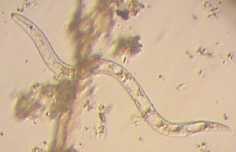 The "roundworms" or "nematodes" (phylum Nematoda) are the most diverse phylum of pseudocoelomates, and one of the most diverse of all animals. Nematode species are very difficult to distinguish; over 28,000 have been described, of which over 16,000 are parasitic. It has been estimated that the total number of described and undescribed roundworms might be more than 500,000. Unlike cnidarians or flatworms, roundworms have a digestive system that is like a tube with openings at both ends.
The "roundworms" or "nematodes" (phylum Nematoda) are the most diverse phylum of pseudocoelomates, and one of the most diverse of all animals. Nematode species are very difficult to distinguish; over 28,000 have been described, of which over 16,000 are parasitic. It has been estimated that the total number of described and undescribed roundworms might be more than 500,000. Unlike cnidarians or flatworms, roundworms have a digestive system that is like a tube with openings at both ends.Nematodes commonly parasitic on humans include ascarids (Ascaris), filarids, hookworms, pinworms (Enterobius) and whipworms (Trichuris trichiura). The species Trichinella spiralis, commonly known as the trichina worm, occurs in rats, pigs, and humans, and is responsible for the disease trichinosis. Baylisascaris usually infests wild animals but can be deadly to humans as well. Dirofilaria immitus are Heartworms known for causing Heartworm disease by inhabiting the hearts, arteries, and lungs of dogs and some cats. Haemonchus contortus is one of the most abundant infectious agents in sheep around the world, causing great economic damage to sheep farms. In contrast, entomopathogenic nematodes parasitize insects and are considered by humans to be beneficial.
One form of nematode is entirely dependent upon fig wasps, which are the sole source of fig fertilization. They prey upon the wasps, riding them from the ripe fig of the wasp's birth to the fig flower of its death, where they kill the wasp, and their offspring await the birth of the next generation of wasps as the fig ripens.
Plant parasitic nematodes include several groups causing severe crop losses. The most common genera are Aphelenchoides (foliar nematodes), Ditylenchus, Globodera (potato cyst nematodes), Heterodera (soybean cyst nematodes), Longidorus, Meloidogyne (root-knot nematodes), Nacobbus, Pratylenchus (lesion nematodes), Trichodorus and Xiphinema (dagger nematodes). Several phytoparasitic nematode species cause histological damages to roots, including the formation of visible galls (e.g. by root-knot nematodes), which are useful characters for their diagnostic in the field. Some nematode species transmit plant viruses through their feeding activity on roots. One of them is Xiphinema index, vector of GFLV (Grapevine Fanleaf Virus), an important disease of grapes.
Other nematodes attack bark and forest trees. The most important representative of this group is Bursaphelenchus xylophilus, the pine wood nematode, present in Asia and America and recently discovered in Europe.














































No comments:
Post a Comment